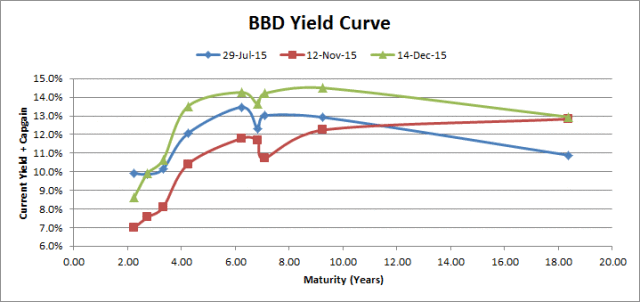With the calamity hitting the preferred shareholders of Dundee Corp (of which I narrowly escaped), I have long noticed that their spinoff corporation, DREAM Unlimited (TSX: DRM) has a similar situation going on with their own preferred shares.
You will have to dig through SEDAR and look for a May 31, 2013 document that is 8783kb in size and go to page 60 of 141 in the PDF document for a legal definition of what these preferred shares are. They made it so convenient as the documents are not even made searchable with the usual control-F function on Adobe Acrobat.
They trade as DRM.PR.A and they are retractable by the corporation at $7.16/share, and redeemable by the shareholder at $7.16/share, in both cases with accrued dividends (7% coupon on a $7.16 par value). Redemption and retraction are given with at least 30 calendar days of notice.
Unlike Dundee Corp, there is no ability for DREAM Unlimited to sneak a shareholder-hostile proposal to scrap the redemption feature without a significant sweetener – if they did so, you can “vote” by exercising your redemption rights and get your money 30 days later instead of voting your shares against such a hypothetical proposal.
The only risk is the underlying corporation, DREAM Unlimited, elects to pay the redemption with common shares. The provision is 95% of the typical 20 day volume weighted average price scheme that is common to a lot of other offerings out there, or $2/share if this is the higher price. DREAM Unlimited common shares are trading at $7/share and with a market capitalization of $526 million, so a dilution of $36.7 million is not going to hammer the common shares below $2 if they tried an equity redemption – you’d likely be able to get out above par value in such an instance. The underlying business is not prone to “gap risk” (i.e. this isn’t some biotechnology company that will drop 70% one day due to a failed clinical trial), but it is in real estate development – this means that any of their properties that are not in Alberta or Saskatchewan, should be relatively stable (at least until you can get your redemption money in 30 days time).
In typical Dundee fashion, however, while the corporation is reporting considerable GAAP profits, their cash flow statements leave much to be desired. They do have ample liquidity in the meantime, having negotiated a $175 million million first-line facility with the banks expiring June 2018 and also $200 million of spare capacity on their operating line of credit which expires on June 2017. There is easily enough room to pay for a redemption of preferred shares – indeed, the fact that the preferred shares occupy a $36.7 million hole on their balance sheet probably forces them to be more conscious about this liability. I wonder why they haven’t even just bitten the bullet and redeemed this expensive capital.
In other words, the market value of this preferred share issue is going to be anchored around the $7.16/share mark as investors are able to skim off a 7% eligible dividend until such time the corporation bites the bullet and finally redeems the shares. If it goes too below $7.16, it is an easy arbitrage to buy below $7.16 and instantly redeem if you believe there is any sense of credit risk. It is as close to a risk-free 7% as it gets.
I note that the preferred shares were trading as low as $7.00 today and this was likely fueled by some investor out there getting his RBC Margin account spontaneously liquidated – it wasn’t a trivial amount either, around 40k shares worth. About 30,000 of them traded at $7.00 and somebody redeeming them back to the corporation at $7.16 made the easiest CAD$5000 on the planet. Ordinarily DRM.PR.A is not an actively traded stock and with all of the stress occurring in the marketplace, what may be “risk-free” isn’t as liquid as cold hard cash!
Anyway, I bought some shares at $7.00 today.
